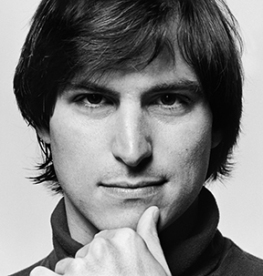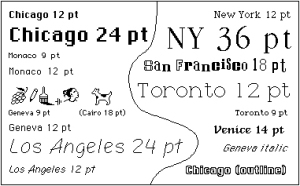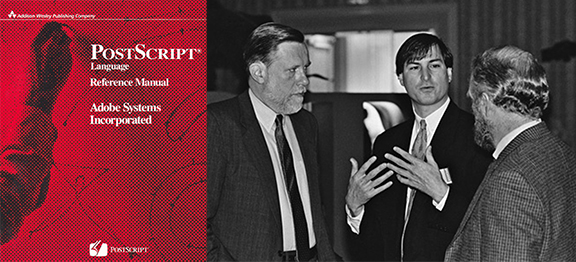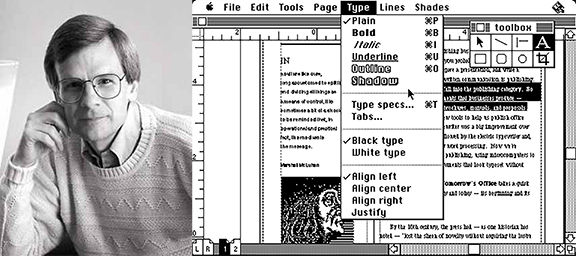Steven P. Jobs’ role in creating the first personal computer (along with his neighborhood friend Steve Wozniak), the founding of Apple Computer and his subsequent firing and return to the company have become part of tech industry lore. His later contributions to mobile, wireless and touch computing—embodied in the Apple iPod, iPhone and iPad—were no less transformative.

Although Steve Jobs had extensive knowledge of computer hardware, operating systems and applications—he even worked for a short time in the early 1970s as a technician for Atari—his greatest skills were as technology visionary, marketer and salesman. Without the entrepreneurial drive, leadership charisma and design esthetic of Steve Jobs, Apple would never have emerged as the world’s largest publicly traded corporation; nor would it have the most loyal customers in the history of the consumer products industries.
Owing a great deal to the location and times of his upbringing, Steve Jobs expressed a broad cultural viewpoint and considered every project and product as an aspect of a larger creative purpose. Having developed an enthusiasm for the Bauhaus movement’s form and function philosophy, he identified design simplicity with products that were both beautiful and easy to use.
In his 2012 biography, Walter Isaacson quotes Steve Jobs from the early 1980s, “So that’s our approach. Very simple, and we’re really shooting for Museum of Modern Art quality. The way we’re running the company, the product design, the advertising, it all comes down to this: Let’s make it simple. Really simple.” Jobs rejected the boxy, bulky and dark industrial style of the earlier generation of computer design in favor of elegance and what he later called “taste.”
It was out of this unique blending of art with science and business that Steve Jobs made two significant contributions to typography and printing technology: the creation of computer fonts and the launching of desktop publishing. As with every innovation associated with his name, Jobs relied on the skills of others to realize his vision and then packaged and presented the accomplishments with great fanfare to investors and consumers alike.
Computer Fonts
Jobs’ esthetic sensibility had been formed a decade earlier while he was briefly a student at Reed College in Portland, Oregon in 1972. After dropping out of school, he enrolled in a calligraphy course at Reed taught by Father Robert Palladino. The course had a lasting impact on him.
As Jobs explained in a commencement address he delivered to Stanford University in 2005: “Reed College at that time offered perhaps the best calligraphy instruction in the country. … I learned about serif and san serif typefaces, about varying the amount of space between different letter combinations, about what makes great typography great. It was beautiful, historical, artistically subtle in a way that science can’t capture, and I found it fascinating.”
“None of this had even a hope of any practical application in my life. But ten years later, when we were designing the first Macintosh computer, it all came back to me. And we designed it all into the Mac. It was the first computer with beautiful typography.”
While working with the Macintosh design team, Jobs was involved in every detail of its size, shape and color as well as every icon, window and box of the graphical user interface. This involvement included the design of a group of fonts which he insisted be named for the great cities of the world: Cairo, Chicago, Geneva, London, Los Angeles, Monaco (monospaced system font), New York, San Francisco, Toronto and Venice.

Prior to the work of Macintosh designer Susan Kare, developer Andy Hertzfeld and engineer Bill Atkinson on proportional fonts, computers were mostly limited to monospaced typefaces much like a typewriter with al alphanumeric characters and keystrokes the exact same width. Jobs could see that the bitmapped display of the Macintosh desktop was capable of rendering typefaces with a sophistication equal to that of letterpress hot metal type and cold phototypesetting.
Others at Apple Computer, due to their limited perspective on the utility of the personal computer, could not relate to Steve Jobs’ insistence on the font library; they considered it a distracting personal obsession. In his biography of Jobs, Walter Isaacson quotes Apple investor and partner Mark Markkula: “I kept saying, ‘Fonts?!? Don’t we have more important things to do?’ ”

When Steve Jobs launched the Macintosh on January 24, 1984 at the Flint Center in Cupertino, the font library was a critical part of the presentation of “the computer for the rest of us.” It was the first desktop system to offer not only the 9 city-named fonts listed above but also style choices—Plain, Bold, Italic, Bold Italic, Underline, Outline, Shadowed—for each.
While initially appearing somewhat primitive, bitmapped and lacking the finesse of professional typography, Jobs’ on-screen fonts were the beginning of a revolution in type technology. Firstly, fonts became something that everyone with a computer could use, not just professional graphic designers and printing specialists.
Secondly, the Macintosh font library encouraged professionals to push the limits of computer-generated typography and eventually transformed the field of typesetting altogether. Soon desktop fonts surpassed the quality and versatility of all previous type technologies and offered WYSIWYG (What You See Is What You Get) output; i.e. the image displayed on the computer screen is precisely what is printed onto a sheet of paper or other final output media.
Desktop Publishing
Steve Jobs understood the promise of WYSIWYG long before the phrase was widely used in the printing and publishing industries. Nearly one year to the day after unveiling the Macintosh, Jobs was back on stage in Cupertino at the annual Apple stockholders meeting on January 23, 1985 to launch the Apple LaserWriter and demonstrate the first ever desktop publishing system.
Desktop publishing signifies an integrated publishing system whereby pages containing both text and graphics are designed in layout software on a desktop computer and printed in individual or multiple copies on a desktop printer. Building on the accomplishments of the Macintosh, Steve Jobs worked throughout 1984 with partner companies and publishing industry experts to integrate the Apple Macintosh computer with other basic elements of desktop publishing: the Apple LaserWriter, Adobe PostScript and Aldus PageMaker.

Apple LaserWriter: Gary Starkweather invented the core toner imaging technology of the laser printer at Xerox PARC in the early 1970s. Although Xerox never brought a desktop laser printer to market, HP and Canon developed systems independently of each other in the 1970s. The HP LaserJet, based on the Canon LBP-CX printing engine, was the first desktop laser printer and was released in 1984. The Apple LaserWriter, developed by a team led by project manager Bruce Blumberg, had two important differences with the HP device: it was networked (with AppleTalk) and could be shared and contained breakthrough PostScript software that enabled true WYSIWYG capability. The Apple LaserWriter was available for purchase in March 1985 and sold for $6,995.

Adobe Postscript: The software at the heart of the Apple LaserWriter was Adobe’s PostScript page description language. John Warnock and Chuck Geschke, who also came from Xerox PARC, founded Adobe Systems in 1982 with PostScript as their flagship product. Warnock and Geschke developed a state-of-the-art device independent print programming language that: 1.) captured all the elements—text, graphics, geometry, etc. —on the page of the desktop layout software during the “Print” function; 2.) interpreted the layout data as vector-based objects within the memory of the printer and; 3.) converted the PostScript objects into raster print data such that the page could to rendered onto a sheet of paper at a resolution of 300 dots per inch. The Adobe founders also signed a licensing agreement with Linotype that made 13 professional typefaces (four styles for each of the Helvetica, Times Roman and Courier families and a Symbol font) “resident” within the PostScript raster image processor (RIP) in the Apple LaserWriter.

Aldus PageMaker: Paul Brainerd—the man who coined the phrase “desktop publishing”—founded Aldus Corporation in February 1984 in Seattle, WA. With a background in computerized newspaper publishing systems, Brainerd and a group of developers began working on layout software initially for newspapers. After getting some early peeks at the Apple Macintosh, Adobe PostScript and Apple LaserWriter, the Aldus team developed PageMaker as the first application capable of placing columns of text and images onto a virtual page and used a floating tool palette. The first commercially available version of PageMaker was released in July 1985 and sold for $495.

An important advisor to Steve Jobs throughout the process was John Seybold, a pioneer in computerized publishing systems and industry consultant. According to Paul Brainerd, “There were a couple of people that really were the glue that made all of this come together, and the most important was Jonathan Seybold. He was consulting to both Adobe and Apple. He and I knew each other for a long time going back … he told me some time during ’84, probably in the first quarter, that there was some confidential information that I needed to know. He got clearance from his clients to be able to share it with me.”
In an account published by Adobe in 2004, Jonathan Seybold reviewed the significance of the events that unfolded during the summer of 1984, “Steve wanted to see me urgently. He said they had a deal with Adobe, they were signing a deal with Linotype, they had real fonts. I went to Cupertino and walked into this tiny room, and there stood Jobs and Warnock with a Mac and a LaserWriter. He showed me what they were up to. I turned to Steve and said, ‘You’ve just turned publishing on its head. This is the watershed event.’ ”
Although they are less celebrated, Steve Jobs’ introduction of the Apple Macintosh font library and his pivotal role in launching the desktop publishing revolution in 1984-85 were watershed developments because they made designing and publishing accessible to anyone with a desktop computer and printer. The lasting impact of Jobs’ breakthrough continues to be felt today in the explosion of online and social media publishing by billions of people across the globe. Jobs’ death from cancer at age 56 on October 5, 2011 prematurely ended the life of one of the most important and unique figures of our times.
